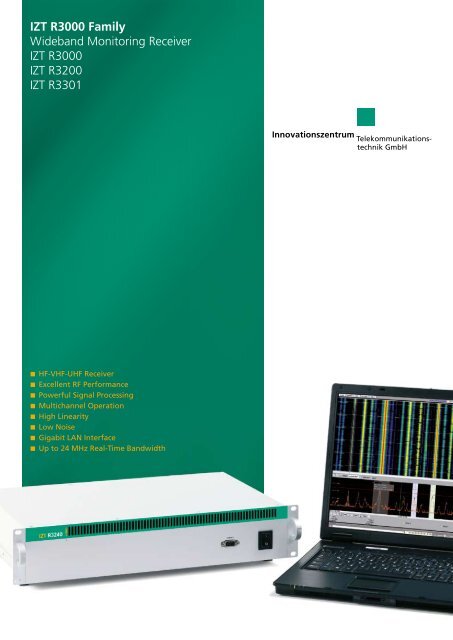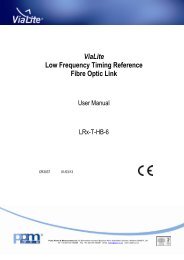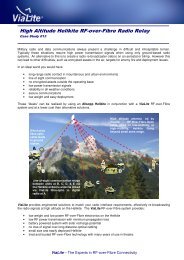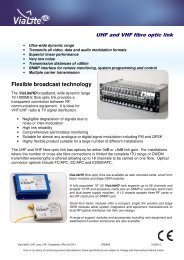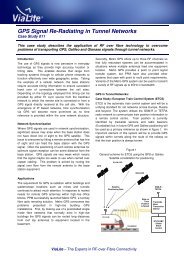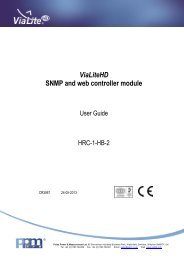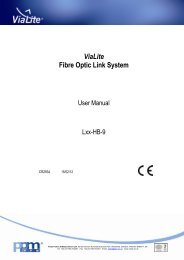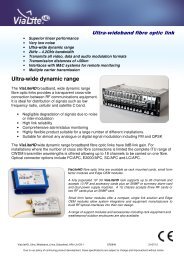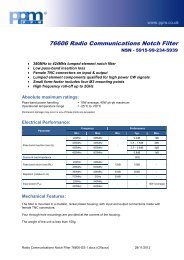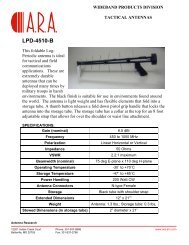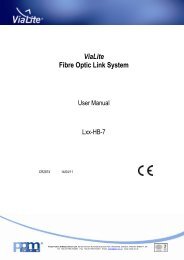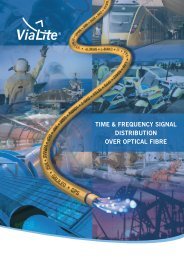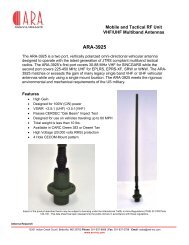Product Information IZT R3000 561.53 KB - Innovationszentrum für ...
Product Information IZT R3000 561.53 KB - Innovationszentrum für ...
Product Information IZT R3000 561.53 KB - Innovationszentrum für ...
You also want an ePaper? Increase the reach of your titles
YUMPU automatically turns print PDFs into web optimized ePapers that Google loves.
<strong>IZT</strong> <strong>R3000</strong> Family<br />
Wideband Monitoring Receiver<br />
<strong>IZT</strong> <strong>R3000</strong><br />
<strong>IZT</strong> R3200<br />
<strong>IZT</strong> R3301<br />
•HF-VHF-UHF Receiver<br />
•Excellent RF Performance<br />
•Powerful Signal Processing<br />
•Multichannel Operation<br />
•High Linearity<br />
•Low Noise<br />
•Gigabit LAN Interface<br />
•Up to 24 MHz Real-Time Bandwidth
<strong>IZT</strong> <strong>R3000</strong> Family<br />
Wideband Monitoring Receiver<br />
Digital Receiver Family for HF – VHF – UHF<br />
The <strong>IZT</strong> <strong>R3000</strong> receiver family is a versatile high performance<br />
wideband receiver system.<br />
The <strong>IZT</strong> <strong>R3000</strong> combines state-of-the-art high frequency<br />
technologies with the latest developments in digital signal<br />
processing thus providing one of the most comprehensive<br />
receiver platforms available today.<br />
Three model variants offer maximum flexibility for every<br />
application:<br />
The <strong>IZT</strong> <strong>R3000</strong> and <strong>IZT</strong> R3200 are 19 inch models with 1 U<br />
respectively 2 U height. Both models are to be used in conjunction<br />
with a controlling PC.<br />
The <strong>IZT</strong> R3301 is a stand-alone system with front control panel.<br />
•Frequency range: 9 kHz - 3 GHz<br />
•Real-time bandwidth up to 24 MHz<br />
•Multichannel operation: up to four independent channels within<br />
24 MHz bandwidth<br />
•IF Filter bandwidth: 6.25 kHz - 24 MHz<br />
•1 Hz tuning resolution<br />
•Digital IF output to Gigabit LAN<br />
•LAN data rate up to 115 MByte/sec<br />
•Output data format:<br />
I/Q complex baseband, complex FFT and PSD<br />
•Optional analog IF output<br />
•Fully remote controllable<br />
•External synchronization enables direction-finder systems<br />
•TDOA location finding platform<br />
•ITU-compliant measurements<br />
•Fast scanning modes<br />
•Analog demodulation<br />
•Available in different form factors<br />
•Front control panel model available (<strong>IZT</strong> R3301)
<strong>IZT</strong> <strong>R3000</strong><br />
High Performance Monitoring<br />
The <strong>IZT</strong> <strong>R3000</strong> family is particularly suitable for<br />
signal search and analysis, spectrum monitoring<br />
in line with ITU recommendations and communication<br />
intelligence.<br />
It allows to analyze and demodulate modern digital<br />
wideband signals as well as to track or intercept<br />
frequency agile systems over a wide range<br />
of bandwidths.<br />
The exceptional performance with outstanding<br />
receive characteristics and a 24 MHz realtime<br />
bandwidth allow for handling of wideband signals<br />
while exceeding the performance of traditional<br />
narrowband receivers.<br />
The <strong>IZT</strong> <strong>R3000</strong> family is the ideal solution for a multitude<br />
of both civilian and military applications:<br />
•radio monitoring of broadcast stations<br />
•ITU-R spectrum monitoring measurements<br />
•real time signal analysis<br />
•spectrum allocation analysis<br />
•automatic signal detection<br />
•search, intercept and emitter location<br />
•direction finding (DF) systems<br />
•TDOA location finding systems<br />
•strategic and tactical reconnaissance systems<br />
•data acquisition, classification and<br />
preprocessing<br />
•threat recognition<br />
•signal recording<br />
•offline processing and technical analysis<br />
•emission compliancy testing<br />
Overview<br />
The <strong>R3000</strong> family covers the frequency range<br />
from 9 kHz to 3 GHz.<br />
Overview of available models:<br />
frequency range <strong>IZT</strong> <strong>R3000</strong> series <strong>IZT</strong> R3200 series <strong>IZT</strong> R3301 series<br />
9 kHz - 30 MHz <strong>IZT</strong> R3020 <strong>IZT</strong> R3220 <strong>IZT</strong> R3301-20<br />
20 MHz - 3 GHz <strong>IZT</strong> R3030 <strong>IZT</strong> R3230 <strong>IZT</strong> R3301-30<br />
9 kHz - 3 GHz <strong>IZT</strong> R3040 <strong>IZT</strong> R3240 <strong>IZT</strong> R3301-40<br />
The receiver family stands out for its world-class<br />
radio frequency performance and digital signal<br />
processing. The integrated high speed processing<br />
core with its 4096-point FFT processor offers a<br />
real-time bandwidth of up to 24 MHz for both<br />
time and frequency domain. Powerful multichannel<br />
signal extraction can be provided by the receiver<br />
which enables for example multichannel<br />
demodulation or other advanced features.<br />
figure 1: Combined Spectrum and Waterfall Display<br />
Scan speeds of up to 4 GHz/s at a frequency resolution<br />
of less than 7.5 kHz can be achieved independent<br />
of any channel allocation. The result is<br />
a panorama frequency scan capable of detecting<br />
2 | 3
LPI-signals (Low Probability of Intercept) as well as<br />
weak signals in the presence of strong neighboring<br />
signals.<br />
The windows based user software is well known<br />
for its simplicity, its reliability and its ease of use.<br />
Various display types like frequency, waterfall and<br />
panorama are available.<br />
When selecting a frequency of interest in the panorama<br />
scan, the receiver will immediately tune to<br />
this frequency and will display the spectrum in<br />
the main display area.<br />
Multiple channels can be demodulated simultaneously<br />
in addition to the wideband spectrum<br />
display. Simply assign a marker to the desired frequency<br />
in the spectrum and select the demodulation<br />
mode. Use the peak search functionality to<br />
assign the demodulators automatically to emissions.<br />
Horizontal lines can be used to limit the<br />
search functionality to a specific power range.<br />
The continuous peak search function uses algorithms<br />
to automatically allocate active channels to<br />
the demodulators. This is especially useful when<br />
monitoring duplex or multi-user communication<br />
on different frequencies.<br />
FFT Spectrum Analyzer<br />
The <strong>IZT</strong> <strong>R3000</strong> family offers advanced spectrum<br />
analyzer functionality based on internal FFT processing<br />
algorithms. Variable bandwidths from<br />
6.25 kHz up to 24 MHz with frequency resolutions<br />
from less than 2 Hz up to 30 kHz can be selected.<br />
Emissions can be measured using individual<br />
markers or bandwidth and power measurement<br />
guides.<br />
The marker functionality covers not only standard<br />
tasks such as normal marker, delta marker and<br />
peak search marker but also phase noise and intermodulation<br />
measurements.<br />
Spectrum data can be recorded continuously limited<br />
only by the size and speed of the controlling<br />
PC’s hard disk. When playing back these recorded<br />
files measurement and monitoring functionality<br />
such as marker- and bandwidth measurements,<br />
zoom and waterfall displays are available in the<br />
same detail as if live signals were received.<br />
All of the receiver’s functions can be remote controlled<br />
via the LAN interface. All receiver data<br />
streams (spectrum, I/Q, demodulated audio) are<br />
available via LAN as well.<br />
The receiver can be integrated into existing user<br />
environments or system solutions by either remote<br />
controlling the windows software or by<br />
low-level integration based on the LAN interface<br />
of the receiver. Further documentation is available<br />
on request.<br />
figure 2:<br />
Panorama scan and 4 MHz spectrum display with three<br />
active demodulation channels<br />
figure 3:<br />
Panorama scan and bandwidth measurement<br />
of OFDM signal
<strong>IZT</strong> <strong>R3000</strong><br />
The zoom functions enable a detailed view of<br />
signals without changing acquisition time or<br />
bandwidth. When using the combined spectrum<br />
and waterfall display, both screens can be<br />
linked. Zooming in the waterfall screen will then<br />
simultaneously display the respective area of the<br />
frequency screen.<br />
Real Time<br />
Bandwidth<br />
Frequency Resolution<br />
(approx.)<br />
Online - Offline<br />
Time Resolution<br />
(approx.)<br />
24 MHz 7.25 kHz 150 μs<br />
16 MHz 4.8 kHz 200 μs<br />
8 MHz 2.4 kHz 400 μs<br />
4 MHz 1.2 kHz 800 μs<br />
3.2 MHz 1.0 kHz 1 ms<br />
1.6 MHz 500 Hz 2 ms<br />
800 kHz 250 Hz 4 ms<br />
400 kHz 125 Hz 8 ms<br />
200 kHz 60 Hz 16 ms<br />
100 kHz 30 Hz 32 ms<br />
50 kHz 15 Hz 65 ms<br />
25 kHz 7.5 Hz 130 ms<br />
12.5 kHz 4 Hz 260 ms<br />
6.25 kHz 2 Hz 520 ms<br />
All received data can be recorded for detailed<br />
analysis or for further post processing. This includes<br />
not only the digital baseband data but also<br />
the spectrum information. Complete scenarios<br />
can be recorded continuously limited only by the<br />
size and speed of the internal hard disk.<br />
When playing back these recorded files, all measurement<br />
and monitoring functionality is available<br />
in the same detail as if receiving live antenna<br />
signals. It is possible to analyze the stored data on<br />
a frame by frame basis, using playback at different<br />
speeds or looping specific areas of interest.<br />
Signal behavior in time and frequency can be<br />
measured in order to identify interferences or<br />
hopping signals by using the spectrogram functionality.<br />
ITU Compliant Monitoring<br />
The <strong>IZT</strong> <strong>R3000</strong> family can be used for civil monitoring<br />
in line with ITU recommendations. As a<br />
FFT-based measuring system the <strong>IZT</strong> <strong>R3000</strong> family<br />
is superior to other systems using standard swept<br />
spectrum analyzer techniques.<br />
Advantages can be seen in acquisition times or in<br />
using advanced methods to measure ITU monitoring<br />
data. For bandwidth measurements the<br />
<strong>IZT</strong> <strong>R3000</strong> family uses for example the FFT results<br />
which allow to measure the occupied bandwidth<br />
of an emission in the sense of the formal<br />
definition (RR No. 1.153).<br />
The following measurements can be performed:<br />
•Spectrum occupancy in line with<br />
ITU-R SM 182/SM 328<br />
•Modulation in line with ITU-R SM328<br />
•Frequency and frequency offset in line with<br />
ITU-R SM377<br />
•Field strength in line with ITU-R SM378<br />
•Bandwidth in line with ITU-R SM443<br />
Most measurements can be performed on up to<br />
three active emissions at the same time by simply<br />
assigning a demodulator to each emission.<br />
Spectrum Occupancy<br />
Measurements<br />
The <strong>IZT</strong> <strong>R3000</strong> family can be used for spectrum occupancy<br />
measurements compliant to ITU recommendations.<br />
The spectrum occupancy measurements<br />
are based on the FFT data generated by the<br />
receiver. The task is to explore, as a function of time,<br />
frequency bands of various widths in the spectrum<br />
between 9 kHz up to 3 GHz for the purpose of detecting<br />
signals above the noise level (noise-ridingthreshold)<br />
or a pre-set threshold (fixed-threshold).<br />
The user can specify the duration of the spectrum<br />
occupancy measurement ranging from minutes to<br />
days and the storage interval within which measurement<br />
results are grouped into intermediate<br />
4 | 5
Scanning Capabilities<br />
figure 4: FM modulation and occupancy measurement<br />
figure 5: Configuration of spectrum occupancy<br />
measurements (detail)<br />
Comprehensive scans are easily performed by the<br />
<strong>IZT</strong> <strong>R3000</strong> family. A frequency scan is defined by<br />
start frequency, stop frequency, dwell time, demodulation<br />
mode, bandwidth, etc. Arbitrary frequency<br />
areas can be excluded from the scan. A<br />
memory scan can be performed by predefining<br />
over up to 20.000 individual channels.<br />
For maximum flexibility, frequency and memory<br />
scans can be combined.<br />
Three distinct scan types can be applied whenever<br />
a channel is detected as active:<br />
•Manual: the scan stops and the current channel<br />
is demodulated until a “continue” command<br />
is received<br />
•Fixed: the scan stops and the current channel is<br />
demodulated for a fixed time<br />
•Automatic: the scan stops and the current<br />
channel is demodulated based on channel<br />
activity. The scan continues after the channel<br />
becomes inactive<br />
statistical results. The final measurement result<br />
accumulates all intermediate statistical results.<br />
It is possible to scan frequency bands defining<br />
only start- and stop-frequency as well as measurement<br />
bandwidth, to scan single channels<br />
with predefined, variable bandwidths or to mix<br />
both methods within the same measurement.<br />
The result of the final measurement assigns<br />
to the observed channel the measured occupancy,<br />
the maximum and average powerlevel<br />
and the relative accuracy of the measurement.<br />
The measurement results and the<br />
corresponding side information are written to a<br />
database. Based on the database the user can<br />
perform further post-processing, e.g. combine<br />
user-defined coherent intermediate statistical results<br />
into more complex statistical analysis.<br />
figure 6: Channel status information during a scan
<strong>IZT</strong> <strong>R3000</strong><br />
Model Variants<br />
<strong>IZT</strong> <strong>R3000</strong><br />
The “original” <strong>IZT</strong> <strong>R3000</strong> receiver. It is mainly designed<br />
for installations where the system’s components<br />
are installed in a 19 inch rack environment.<br />
With only 1 U height multiple receivers can<br />
be stacked.<br />
CISPR 25 for extremely low RF emissions. The AC<br />
and DC power supply is completed by an uninterrupted<br />
power supply (UPS) for changeover periods<br />
and for the accommodation of load surges.<br />
An internal GPS module adds location information<br />
to the received signals.<br />
Customer-specific variants<br />
The modular design of the <strong>IZT</strong> <strong>R3000</strong> offers the<br />
possibility to customer-specific mechanical modifications.<br />
This ranges from simple additional antenna<br />
inputs over multiple receivers in one housing<br />
to complex modifications like water-cooling.<br />
Please contact <strong>IZT</strong> for further information.<br />
<strong>IZT</strong> R3200<br />
The <strong>IZT</strong> R3200 has a convenient form factor for<br />
most single user applications. It features a significantly<br />
reduced depth compared to the <strong>IZT</strong> <strong>R3000</strong><br />
in a 19 inch 2 U form factor. The support brackets<br />
and the feet can be removed if desired.<br />
<strong>IZT</strong> R3301<br />
With its front panel control, touch screen and<br />
integrated processing hardware the <strong>IZT</strong> R3301 is<br />
the perfect portable monitoring system. While is<br />
has a compact and rugged design, it also meets<br />
Data Types<br />
With powerful FPGA based processing the <strong>IZT</strong><br />
<strong>R3000</strong> generates multiple data streams simultaneously<br />
in time and frequency domain.<br />
Time Domain<br />
I/Q complex baseband signals are the basis for<br />
various applications. The <strong>IZT</strong> <strong>R3000</strong> family digitizes<br />
the wideband analog signals. The following<br />
downconversion stage generates an I/Q complex<br />
baseband signal. High performance digital filters<br />
with stop band attenuation beyond 100 dB<br />
narrow the effective signal bandwidth to user selectable<br />
bandwidths in the range of several kHz<br />
up to 24 MHz.<br />
The I/Q complex baseband signal is delivered<br />
in 16-bit signed integer format, which can be<br />
changed to 32-bit signed integer for maximum<br />
dynamic range when operating in very narrow<br />
band modes.<br />
Frequency Domain<br />
Many applications require frequency domain signals.<br />
In order to reduce the processing effort of<br />
subsequent enduser equipment, a high performance<br />
4096-point FFT has been incorporated into<br />
the <strong>IZT</strong> <strong>R3000</strong> family. The integrated polyphase<br />
windowing offers much better adjacent channel<br />
rejection compared to simple window functions. 6 | 7
The resulting complex FFT data is delivered in<br />
24-bit resolution. Power Spectral Density (PSD)<br />
data - the magnitude representation of the complex<br />
FFT - is known from typical spectrum analyzers.<br />
The <strong>IZT</strong> <strong>R3000</strong> family supports adjustable<br />
averaging factors for PSD data up to a factor of<br />
128. The PSD data is delivered in 16-bit integer<br />
format covering a logarithmic range of 255 dB<br />
with a resolution of less than 0.01 dB.<br />
Mutichannel Operation<br />
Using the multichannel feature up to four independent<br />
channels – each capable of providing<br />
I/Q, FFT and PSD data – can be extracted from the<br />
wideband input signal.<br />
All channels can be set to independent center frequencies,<br />
bandwidths and averaging factors, but<br />
must be placed within the maximum real-time<br />
bandwidth of up to 24 MHz.<br />
Application Example 1:<br />
Distribution of processing load<br />
A part of the spectrum with a bandwidth of 24<br />
MHz shall be further processed by external PCs.<br />
Due to processing requirements this might not be<br />
possible by using only a single PC.<br />
The multichannel option can be used to split the<br />
spectrum into four single segments, even with<br />
overlapping bandwidths, for example 6 MHz for<br />
each segment.<br />
Now the load can be distributed to four independent<br />
PCs as each single data stream can be sent<br />
to individual IP-addresses.<br />
Application Example 2:<br />
Monitoring the spectrum<br />
One channel can be set to continuously monitor<br />
wideband spectrum (PSD) at the maximum bandwidth<br />
of 24 MHz. The remaining three channels<br />
can then be configuired to receive medium- or<br />
narrow-band complex baseband I/Q signals for<br />
demodulation at the same time.<br />
Receiver Interfaces<br />
Gigabit LAN<br />
All digital signal and control data is transmitted<br />
and received via Gigabit Ethernet LAN. This allows<br />
fast, simple and cost efficient integration of<br />
the <strong>IZT</strong> <strong>R3000</strong> family into an existing IT environment.<br />
Gigabit LAN offers data rates of up to<br />
115 MBytes/sec provided that the host PC is<br />
capable of receiving continuous data at this rate.<br />
Instantaneous Bandwidth (single channel):<br />
• I/Q Baseband: .................19.2 MHz<br />
• FFT (complex):.................19.2 MHz<br />
• PSD (power spectral density): . . . . . 24.0 MHz<br />
An I/Q bandwidth of up to 20.5 MHz can be<br />
achieved when reducing the stopband attenuation<br />
requirements. The receiver has the capability<br />
to discard FFT frames in order to reduce data<br />
throughput. Using this feature the maximum FFT<br />
bandwidth can be extended to 24 MHz.<br />
When multiple data types or multichannel operation<br />
are used the maximum Gigabit LAN data<br />
rate has to be taken into account. Please refer<br />
to chapter multichannel operation for application<br />
examples.<br />
Antenna<br />
Separate N-type connectors for HF and VUHF<br />
are available for the antenna signals as standard<br />
configuration. Various options can be selected in<br />
order to match the receiver to the conditions of<br />
the installation site:<br />
•<strong>IZT</strong> <strong>R3000</strong>-AAI-HF: a second N-type antenna<br />
input for the HF frequency range<br />
•<strong>IZT</strong> <strong>R3000</strong>-AAI-VUHF: a second N-type<br />
antenna input for the VUHF frequency range<br />
•<strong>IZT</strong> <strong>R3000</strong>-AAI-RF1: a single N-type antenna<br />
input for the HF and VUHF frequency range<br />
•<strong>IZT</strong> <strong>R3000</strong>-AAI-RF2: one of the two default<br />
antenna inputs serves as an single antenna<br />
input for the HF and VUHF frequency range
<strong>IZT</strong> <strong>R3000</strong><br />
Synchronization<br />
The <strong>IZT</strong> <strong>R3000</strong> family features a high stability internal<br />
reference clock. The receiver can be synchronized<br />
to an external 10MHz reference source.<br />
With option <strong>IZT</strong> <strong>R3000</strong>-TRIG an additional trigger<br />
pulse or 1PPS signal can be used to synchronize<br />
multiple receivers with sample accuracy. This is<br />
required for direction finder applications and is<br />
usually sufficient for goniometric or Watson-Watt<br />
DF applications.<br />
In order to realize DF systems based on a singlereceiver<br />
architecture the option <strong>IZT</strong> <strong>R3000</strong>-FTRIG<br />
can be used to accept antenna synchronization<br />
pulses at intervals of 100 μs and less.<br />
For the phase coherent synchronization of multiple<br />
receivers the option <strong>IZT</strong> <strong>R3000</strong>-EXT_SYNC<br />
provides external synchronization interfaces for<br />
the clock and the local oscillator signals.<br />
Remote Control<br />
Windows Software<br />
The <strong>IZT</strong> <strong>R3000</strong> windows software can be remote<br />
controlled. The demodulated audio is available<br />
in addition to the I/Q and spectrum data of the<br />
receiver on individual UDP ports. Remote controlling<br />
the <strong>IZT</strong> <strong>R3000</strong> windows software offers<br />
a quick and convenient way to embed the <strong>IZT</strong><br />
<strong>R3000</strong> family into an existing user environment.<br />
LAN interface<br />
For integration into customer-specific systems the<br />
receiver can be interfaced on Ethernet LAN level.<br />
Multiple sockets are available: One for each signal<br />
data stream (I/Q, FFT, PSD) and multiple sockets<br />
for the monitoring and control port. The signal<br />
data streams consist of raw data preceded by<br />
meta data specifying the signal, such as center<br />
frequency, bandwidth, attenuation, time-of-arrival,<br />
clipping indicator, gaps, etc. The monitoring<br />
and control port employs a user-friendly ASCII<br />
format to command and configure the receiver.<br />
8616<br />
PSD<br />
8612<br />
SPECTRUM DISPLAY<br />
<strong>R3000</strong> GUI<br />
<strong>R3000</strong><br />
RECEIVER<br />
IQ_1<br />
8620<br />
FILTER & RESAMPLE<br />
DEMODULATION<br />
IQ_2<br />
8630<br />
FILTER & RESAMPLE<br />
DEMODULATION<br />
IQ_3<br />
8640<br />
FILTER & RESAMPLE<br />
DEMODULATION<br />
8645 8635 8625<br />
UDP port numbers based on default base adress 8610<br />
8644 8634 8624<br />
figure 7: UDP ports of <strong>R3000</strong> GUI available for remote applications<br />
8 | 9
Technical Specifications<br />
Frequency Range HF 9 kHz to 30 MHz 1)<br />
VUHF 20 MHz to 3 GHz 2)<br />
RF Input Impedance 50 Ohm<br />
Maximum Input Power HF +20 dBm, +30 dBm with input attenuator active<br />
VUHF<br />
Tuning Resolution HF, VUHF 1 Hz<br />
+15 dBm<br />
VSWR HF, VUHF < 2.1<br />
Tuning Accuracy HF, VUHF < 0.2 Hz<br />
Reference Frequency HF, VUHF 10 MHz internal/external<br />
Internal Reference Stability HF, VUHF < 1x10 -7<br />
Input Sensitivity<br />
HF: 100 kHz - 30 MHz<br />
@ S/N = 10 dB<br />
VUHF: 20 MHz - 3 GHz<br />
@ S/N = 10 dB<br />
-120 dBm @ 3 kHz BW<br />
-111 dBm @ 25 kHz BW<br />
-114 dBm @ 3 kHz BW<br />
-105 dBm @ 25 kHz BW<br />
-92 dBm @ 500 kHz BW<br />
Oscillator Phase Noise HF -130 dBc/Hz typical @ 1 kHz offset<br />
-140 dBc/Hz typical @ 10 kHz offset<br />
VUHF<br />
-120 dBc/Hz typical @ 10 kHz offset<br />
Sweep Time HF, VUHF < 3 ms<br />
Scanning Speed HF, VUHF > 4 GHz/s<br />
Input IP3 HF +40 dBm typical<br />
VUHF<br />
+24 dBm, typical (Low Distortion Mode)<br />
+13 dBm, typical (Normal Mode)<br />
Noise Figure HF 9 dB typical<br />
VUHF<br />
10 dB (f < 2 GHz) - 12 dB (f > 2 GHz), typical (Low Noise Mode)<br />
13 dB (f < 2 GHz) - 15 dB (f > 2 GHz), typical (Normal Mode)<br />
IF Rejection HF not applicable<br />
VUHF<br />
>120 dB typical<br />
Image Rejection HF not applicable<br />
VUHF<br />
>110 dB typical<br />
Oscillator reradiation<br />
HF<br />
not applicable<br />
at antenna output<br />
VUHF<br />
< -110 dBm<br />
Preselector HF 12-Band<br />
VUHF<br />
11-Band<br />
IF Bandwidth HF, VUHF 6.25 kHz to 24 MHz<br />
Analog to Digital Converter SFDR, HF 90 dB typical (referenced to full scale of A/D converter)<br />
SFDR, VUHF<br />
75 dB typical (referenced to full scale of A/D converter)<br />
Digital Postprocessing Digital downconverter Variable decimation<br />
Complex baseband<br />
Variable bandwidth: 6.25 kHz to 24 MHz<br />
Complex FFT<br />
32 bit complex, 1024 and 4096-point-FFT, polyphase filter<br />
Variable bandwidth: 6.25 kHz to 24 MHz<br />
Power density spectrum Magnitude and logarithm of complex FFT<br />
Averaging Variable averaging of PSD by 1, 2, 4, 8, 16, 32, 64 or 128<br />
Digital Data Format Complex baseband 16 bit or 32 bit signed integer, I and Q samples<br />
Complex FFT<br />
16 bit floating point, complex 1024 or 4096 FFT<br />
Power density spectrum 16 bit unsigned integer, 1024 or 4096 FFT,<br />
logarithmic scaling, range 256 dB<br />
Maximum data rate<br />
115 MByte/sec
<strong>IZT</strong> <strong>R3000</strong><br />
Demodulation Channels up to three, demodulated simultaneously<br />
All following demodulation parameters can be set for each channel individually<br />
Demodulation modes AM, FM, FM-W, PM, Pulse, USB, LSB, ISB, CW, I/Q<br />
IF filter<br />
additional bandpass filtering 0 to100% of IF bandwidth<br />
IF notch<br />
unlimited notches within IF bandwidth<br />
Squelch<br />
-140 dBm to -40 dBm, resolution 1 dB<br />
Audio filter<br />
bandpass 300 Hz to 3300 Hz, lowpass 15 kHz<br />
Audio Notch<br />
two notch filters, center frequency 0 to 22 kHz<br />
Measurement Signal level -160 dBm to +20dBm, resolution 0,1 dB<br />
Frequency offset<br />
up to ½ IF bandwidth, resolution 1 Hz<br />
AM modulation depth AM, AM+, AM+; m = 0% to 99.9%; resolution ≤ 0.1%<br />
Indication error ≤ 5% (S/N=40 dB, AF = 1 kHz, tmeas < 1s)<br />
FM deviation<br />
FM, FM+, FM-; Δf = 0 Hz to 10 MHz; resolution 1 Hz<br />
PM<br />
Bandwidth measurement<br />
Interfaces Antenna input, HF, VUHF N, female, 50 Ω<br />
External reference input<br />
External trigger pulse<br />
External synchronization<br />
Service interface<br />
LAN<br />
Indication error ≤ 2% of occupied IF-bandwidth<br />
(S/N = 40 dB, AF = 1 kHz, tmeas < 1s)<br />
Δφ = 0 rad to 12.5 rad; resolution = 0.01 rad<br />
Indication error < 0.1 rad (S/N=40 dB, AF = 1 kHz, tmeas < 1s)<br />
automatic, up to 24 MHz bandwidth<br />
SMA, female, 50 Ω<br />
SMA, female, CMOS 3.3 Volt (5 Volt tolerant input)<br />
6x SMA, female, 50 Ω<br />
RS232, D-SUB 9, male<br />
1 Gigabit LAN, CAT6, legacy support for 100MBit<br />
General Data <strong>IZT</strong> <strong>R3000</strong> <strong>IZT</strong> R3200 <strong>IZT</strong> R3301<br />
Operating temperature 0°C to +50°C 0°C to +50°C 0 to +45°C<br />
Storage temperature -40°C to +70°C -40°C to +70°C -20°C to +60°C<br />
Humidity max. 85%, non-condensing max. 85%, non-condensing max. 85%, non-condensing<br />
EMI / EMC EN 61010-1:2002 EN 61010-1:2002 EN 55022<br />
EN 61000-6-2:2002 EN 61000-6-2:2002 EN 55025<br />
EN 61000-6-3:2002 EN 61000-6-3:2002<br />
MTBF > 10 000 hrs (MIL-HDBK) > 10 000 hrs (MIL-HDBK) > 10 000 hrs (MIL-HDBK)<br />
Power supply<br />
90 - 264 V, 50 - 60 Hz,<br />
50 VA - 80 VA depending on<br />
configuration<br />
AC: 90 - 264 V, 50 - 60 Hz,<br />
50 VA - 80 VA depending on<br />
configuration<br />
DC: 10 - 30 V, 50 W - 80 W<br />
depending on configuration 3)<br />
AC: 100 - 240 V, 47- 63 Hz,<br />
240 VA<br />
DC: 10 - 30 V, 150 W<br />
UPS: 21.6 V, 2.4 Ah, 56.4 Wh,<br />
Li-Ion<br />
Dimensions (WxHxD) 19” x 1 U x 560 mm 19” x 2 U x 320 mm 450 x 347 x 239 mm<br />
Weight <strong>IZT</strong> R3020: 10 kg <strong>IZT</strong> R3220: 10 kg approx. 17 kg<br />
<strong>IZT</strong> R3030: 11 kg<br />
<strong>IZT</strong> R3230: 11 kg<br />
<strong>IZT</strong> R3040: 12 kg<br />
<strong>IZT</strong> R3240: 12 kg<br />
1)<br />
degraded performance: 9 kHz to 500 kHz 2) degraded performance: 20 MHz to 30 MHz 3) with option <strong>R3000</strong>-DCW<br />
Specification subject to change without further notice.<br />
10 | 11
<strong>IZT</strong> <strong>R3000</strong> Family<br />
Wideband Monitoring Receiver<br />
Ordering Guide<br />
HF Receiver <strong>IZT</strong> R3020 HF Receiver, frequency range 9 kHz – 30 MHz, 1 U<br />
<strong>IZT</strong> R3220<br />
HF Receiver, frequency range 9 kHz – 30 MHz, 2 U<br />
<strong>IZT</strong> R3301-20<br />
HF Receiver with front panel controls,<br />
frequency range 9 kHz –30 MHz<br />
VUHF Receiver <strong>IZT</strong> R3030 VUHF Receiver, frequency range 20 MHz – 3 GHz, 1 U<br />
<strong>IZT</strong> R3230<br />
VUHF Receiver, frequency range 20 MHz – 3 GHz, 2 U<br />
<strong>IZT</strong> R3301-30<br />
VUHF Receiver with front panel controls,<br />
frequency range 20 MHz – 3 GHz<br />
HF-VUHF Receiver <strong>IZT</strong> R3040 HF-VUHF Receiver, frequency range 9 kHz –3 GHz, 1 U<br />
<strong>IZT</strong> R3240<br />
HF-VUHF Receiver, frequency range 9 kHz – 3 GHz, 2 U<br />
<strong>IZT</strong> R3301-40<br />
HF-VUHF Receiver with front panel controls,<br />
frequency range 9 kHz – 3 GHz<br />
Software <strong>IZT</strong> <strong>R3000</strong>-GUI Windows based user software<br />
<strong>IZT</strong> <strong>R3000</strong>-MONITORING ITU compliant measurement module for <strong>IZT</strong> <strong>R3000</strong>-GUI<br />
Receiver Options <strong>IZT</strong> <strong>R3000</strong>-RF6 Frequency range extension 3 GHz – 6 GHz 1)<br />
<strong>IZT</strong> <strong>R3000</strong>-RF18 Frequency range extension 3 GHz – 18 GHz 1)<br />
<strong>IZT</strong> <strong>R3000</strong>-AAI-HF<br />
Additional antenna interface for HF<br />
<strong>IZT</strong> <strong>R3000</strong>-AAI-VUHF Additional antenna interface for VUHF<br />
<strong>IZT</strong> <strong>R3000</strong>-AAI-RF1 Additional antenna interface type 1<br />
<strong>IZT</strong> <strong>R3000</strong>-AAI-RF2 Additional antenna interface type 2<br />
<strong>IZT</strong> <strong>R3000</strong>-TRIG<br />
External trigger interface<br />
<strong>IZT</strong> <strong>R3000</strong>-FTRIG<br />
External fast trigger interface<br />
<strong>IZT</strong> <strong>R3000</strong>-EXT_SYNC External synchronization interfaces 2)<br />
<strong>IZT</strong> <strong>R3000</strong>-IFOUT<br />
Analog IF output<br />
<strong>IZT</strong> <strong>R3000</strong>-DCW Wide DC input, 10–30 Volt 3)<br />
<strong>IZT</strong> <strong>R3000</strong>-OCX<br />
<strong>IZT</strong> <strong>R3000</strong>-BST<br />
Oven stabilized reference oscillator<br />
Bias-T, adjustable, 3–12 Volt, 30–200mA<br />
1)<br />
Detailed specification available separately<br />
2)<br />
Phase synchronized data acquisition requires external clock generation. Available on request.<br />
3)<br />
Only available for model <strong>IZT</strong> R3200, default for model <strong>IZT</strong> R3301<br />
<strong>Innovationszentrum</strong> für<br />
Telekommunikationstechnik GmbH <strong>IZT</strong><br />
General Manager: Rainer Perthold<br />
Am Weichselgarten 5, D-91058 Erlangen, Germany<br />
Phone: +49 (0)9131 4800-100 Fax:-190<br />
sales@izt-labs.de www.izt-labs.de<br />
About <strong>IZT</strong><br />
The <strong>Innovationszentrum</strong> fuer Telekommunikationstechnik GmbH <strong>IZT</strong> specializes in<br />
the most advanced digital signal processing and field programmable gate array<br />
(FPGA) designs in combination with high frequency and microwave technology.<br />
The product portfolio includes equipment for signal generation, receivers for signal<br />
monitoring and recording, transmitters for digital broadcast, digital radio systems,<br />
and channel simulators. <strong>IZT</strong> offers powerful platforms and customized solutions for<br />
high signal bandwidth and real-time signal processing applications. The product and<br />
project business is managed from the principal office located in Erlangen/Germany.<br />
<strong>IZT</strong> distributes its products worldwide together with its international strategic partners.<br />
The customers are civil companies, governmental agencies and armed forces.<br />
The <strong>IZT</strong> quality management system is ISO 9001:2000 certified.


